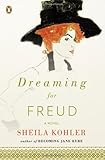Freudian Psychology
How to Braid the Strands of Your Story Together
How can we bring the complexity of life into a true story or one that seems true
Posted October 29, 2014
When we try to tell our stories we are often confronted by several threads which all seem as important. This is the same whether we are telling our personal story in an essay or writing up someone else’s. Where to begin? Where to end? What to leave in or take out?
If we take Freud’s five case histories we can see that in each one he was confronted by various threads as we all are. In the Dora case there is Dora’s story with her father, with her would-be lover, Herr K. whom Freud insists she desires, and with Herr K’s wife, Frau K whom she admits she admires. There is Dora’s story with her own mother who is obsessed with her household and its cleanliness.
In “Little Hans” we have the little boy’s relationship with his father, his mother, who is both seductive and punitive, and with little Hannah, his sister whom he both loves and hates.
In the Ratman we have Ernst Lanzer’s relationship with his governesses, his father; his brother ( whom he shoots with a toy gun) and with the cruel captain who tells him of the terrible torture.
In the Wolfman we have again the father and mother, and here the sister who seduces and torments him; his nanja whom he adores.
In Schreber we have his relationship with the punitive father, his wife; his therapist and his God.
In all five cases, of course, we have most importantly the relationship with Freud himself, our narrator and guide.
How to braid all these stories together and make them into a satisfying whole? There is in each one of these cases an overarching question: what lies at the heart of the symptoms evoked here. Each one of these separate threads is gradually braided into the whole to conclude with Freud’s final diagnosis. In each one of these separate stories there is a question the reader wants answered and this answer is added to the whole and advances the initial question and discovery of what ails the patient.
Thus in my own case in a recent personal essay called “A Common Ancestor” I started with a scene where my husband announced his love for another woman: the initial question is then what will happen to this marriage, this woman, and this man. The essay then brings in the thought the wife has which is that she wishes to die, but I say in the essay, she is not the one to die young. We wonder of course who this will be. Next I bring in the middle daughter who is deaf and quite wild. Will she be the one? Or is it the reckless husband who leaves in a hurry in his green Porsche? Next the wife leaves to meet her sister in Rome.
You will have to read to the end of the essay ( to come in Subtropics) to find out what happens, but all of this is brought full circle and back to the place of the initial scene and the wayward husband and what happens to both of them.
Sheila Kohler is the author of many books including Becoming Jane Eyre and the recent Dreaming for Freud.
Becoming Jane Eyre: A Novel (Penguin Original) by Sheila Kohler Penguin Books click here
Dreaming for Freud: A Novel by Sheila Kohler Penguin Books click here




